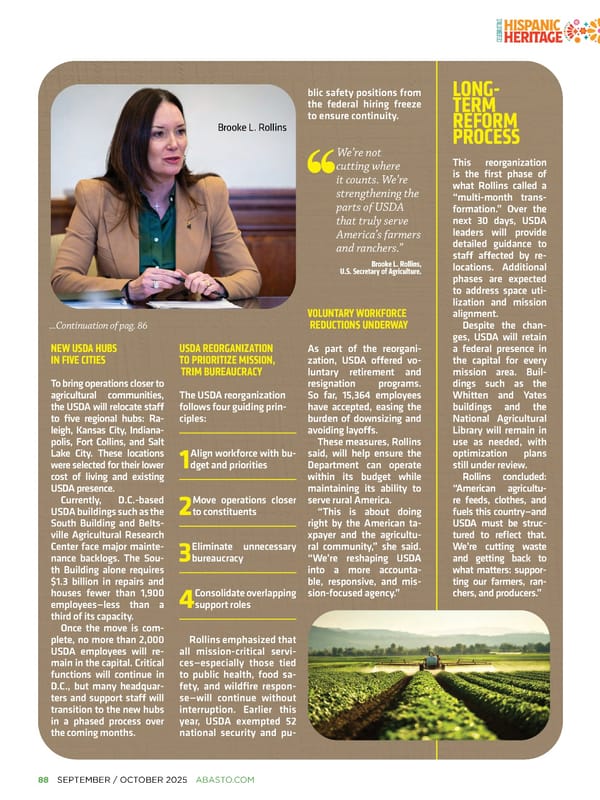88�SEPTEMBER / OCTOBER 2025�ABASTO.COM NEW USDA HUBS IN FIVE CITIES To bring operations closer to agricultural communities, the USDA will relocate staf to five regional hubs: Ra- leigh, Kansas City, Indiana- polis, Fort Collins, and Salt Lake City. These locations were selected for their lower cost of living and existing USDA presence. Currently, D.C.-based USDA buildings such as the South Building and Belts- ville Agricultural Research Center face major mainte- nance backlogs. The Sou- th Building alone requires $1.3 billion in repairs and houses fewer than 1,900 employees—less than a third of its capacity. Once the move is com- plete, no more than 2,000 USDA employees will re- main in the capital. Critical functions will continue in D.C., but many headquar- ters and support staf will transition to the new hubs in a phased process over the coming months. USDA REORGANIZATION TO PRIORITIZE MISSION, TRIM BUREAUCRACY The USDA reorganization follows four guiding prin- ciples: 1 Align workforce with bu- dget and priorities 2 Move operations closer to constituents 3 Eliminate unnecessary bureaucracy 4 Consolidate overlapping support roles Rollins emphasized that all mission-critical servi- ces—especially those tied to public health, food sa- fety, and wildfire respon- se—will continue without interruption. Earlier this year, USDA exempted 52 national security and pu- blic safety positions from the federal hiring freeze to ensure continuity. We’re not cutting where it counts. We’re strengthening the parts of USDA that truly serve America’s farmers and ranchers.” Brooke L. Rollins, U.S. Secretary of Agriculture. VOLUNTARY WORKFORCE REDUCTIONS UNDERWAY As part of the reorgani- zation, USDA ofered vo- luntary retirement and resignation programs. So far, 15,364 employees have accepted, easing the burden of downsizing and avoiding layofs. These measures, Rollins said, will help ensure the Department can operate within its budget while maintaining its ability to serve rural America. “This is about doing right by the American ta- xpayer and the agricultu- ral community,” she said. “We’re reshaping USDA into a more accounta- ble, responsive, and mis- sion-focused agency.” Brooke L. Rollins ...Continuation of pag. 86 LONG- TERM REFORM PROCESS This reorganization is the first phase of what Rollins called a “multi-month trans- formation.” Over the next 30 days, USDA leaders will provide detailed guidance to staf afected by re- locations. Additional phases are expected to address space uti- lization and mission alignment. Despite the chan- ges, USDA will retain a federal presence in the capital for every mission area. Buil- dings such as the Whitten and Yates buildings and the National Agricultural Library will remain in use as needed, with optimization plans still under review. Rollins concluded: “American agricultu- re feeds, clothes, and fuels this country—and USDA must be struc- tured to reflect that. We’re cutting waste and getting back to what matters: suppor- ting our farmers, ran- chers, and producers.”
 Abasto Magazine: September/October 2025 ENGLISH Page 103 Page 105
Abasto Magazine: September/October 2025 ENGLISH Page 103 Page 105